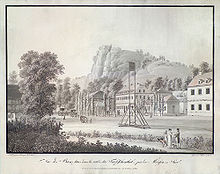Bush bath
Buschbad is a district of Meißen in Saxony . It is located three kilometers southwest of Meißen in the Triebisch valley and belongs to the Dobritz district .
geography
Buschbad is located in the valley floor of the deeply cut Triebischtal between Garsebach and the Triebischtal district of Meißner . To the west rises a 60 to 80 m high Pechsteinzug with the Götterfelsen and the summit of the Hohe Eifer .
history
The Meißner official physician and doctor of the Princely School St. Afra , Dr. Peter Johann Daniel Lutheritz, discovered in 1796 a source of iron ( iron acid ) not far from the Busch mill . Lutheritz let the water u. a. Chemically investigated by Johann Gottfried Leonhardi and, after the confirmation of the healing effect, built a cold-water sanatorium with a bathhouse and residential building for the bathers. The name "Buschbad" chosen for the institution was derived from the neighboring Busch mill. Lithographs show that the bathroom was still in use around 1830. When the mineral spring slackened in intensity, people started using foreign mineral waters and administering milk cures . The bathroom died around 1850; in 1871 it had been described for several years as a bathroom that was not in use.
At this time, industrialization found its way into the Triebischtal and in 1834 the brothers Carl and Franz Ludwig Jacobi acquired the old leather mill below the Hohe Eifer and converted it into an iron foundry and machine factory, which became the first large industrial company in Meißen. In 1897 the Meissner iron foundry and mechanical engineering company was converted into Jacobiwerk AG.
In the Triebischschleife below the Götterfelsen several clay and fireclay factories were built from 1875 onwards .
After the Second World War , the machine factory was shut down and demolished. A housing estate was built in their place in 1954. The Institute for the Refractory Industry and VEB Ceramics emerged from the clay works .
Buschbad had a train station on the narrow-gauge railway Wilsdruff - Meißen-Triebischtal - Lommatzsch, which was operated from 1909 to 1966 .
Today the Buschmühle is the only preserved watermill in Meißen and has been renovated. Today the facility houses physiotherapy and assisted living facilities as well as a restaurant .
literature
- Peter Johann Daniel Lutheritz: Physico-chemical description of the bush bath near Meissen and a sanitary facility to be connected with it . Dresden 1798 ( digitized version )
- Wolfgang Schanze: Former mineral springs in the Meißen district. in: Sächsische Heimatblätter, issue 5/1977, p. 236
Web links
Coordinates: 51 ° 8 ' N , 13 ° 28' E


